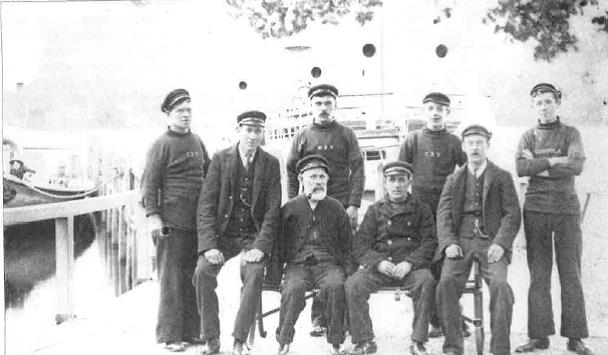Gondola
Keep the home fires burning
The Steam Yacht GONDOLA was commissioned in 1859 for the Coniston Railway Company who had seen the opportunity to transport tourists to the Lake District with the highlight of a cruise on one of the lakes. Her hull of 1/8" thick steel plates, flush riveted to wrought iron frames, was transported in four sections by rail and heavy horses to Coniston Old Hall from her builders, Jones Quiggin & Co., of Sefton Street, Liverpool.
She entered service on Coniston Water in 1860, but two years later the company was acquired by the Furness Railway Company. Between 1897 and 1906 the number of passengers increased from 14,264 to 22,445, and a second vessel, the LADY OF THE LAKE, was launched in 1908. Both vessels maintained regular sailings until the First World War, but on 12 August 1914, soon after the outbreak of war, LADY OF THE LAKE was withdrawn from service. However, GONDOLA remained in service until the end of the 1914 season.

Crew of Gondola 1910
Initially the Furness Railway Company intended to run GONDOLA for a short season in 1915, but by 10 June the Board had decided to suspend any further sailings for the duration of the war, for commercial reasons. They noted that only the Captain (Felix Hamill), an engineer and a boy were needed to crew her, but that receipts would almost certainly be less than the £57 per month needed to keep her running. Two of the long established cruises, the Inner and Middle Tours, connected by road with bus services which had been withdrawn, would have to be discontinued.
The decision to suspend the service would cause enormous inconvenience to local people, and a great loss of trade to boarding houses and village residents. A petition signed by 28 residents against the decision to close it was submitted to the Furness Railway Company. But on 23 July 1915 the Board confirmed its decision and GONDOLA was laid up, in the care of Captain Hamill. But local protests continued. In May 1916 the Board considered a letter from Mr Joe Tyson of the Waterhead Hotel asking it to re-instate the service for the summer of that year. Two further protest letters were considered, but the Board re-affirmed its suspension decision in June 1916.
Soon after the war, sailing recommenced, and both vessels returned to service. With recommissioning of the bus services the circular tours were re-instated. Both GONDOLA and LADY OF THE LAKE continued operating until the outbreak of war in 1939. In 1923, GONDOLA’s copper locomotive-type boiler was replaced by a steel boiler, and her engine was removed and sold in 1944. She was converted to a house boat but eventually rebuilt in 1980.
GONDOLA later became one of the inspirations for Capt. Flint's houseboat in Arthur Ransome's novels Swallows and Amazons. A postcard of SY GONDOLA, with changes made by Arthur Ransome to transform it into his vision of Captain Flint's Houseboat, is now in the Arthur Ransome collection held at The Brotherton Library, University of Leeds.
Where is she now?
GONDOLA is currently located at Coniston Water where she is operating commercially as a passenger vessel by the National Trust. Gondola is on the water from 1 April until 31 October.
Sources
Brouwer, Norman J, (1993) International Register of Historic Ships.
Steamboat Register: An illustrated register of surviving steam vessels in the British Isles (1994).
Andrews, M. and Holme, G. (2012). The Coniston Railway. Pinner, Middlesex: Cumbrian Railways Association.
The Ruskin Museum, Yewdale Road, Coniston, Cumbria.
Furness Railway Company: Minutes of Directors Meetings, TNA, Kew, London. RAIL/22-28.
